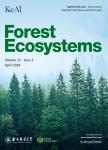Conversion of pure Chinese fir plantation to multi-layered mixed plantation enhances the soil aggregate stability by regulating microbial communities in subtropical China
Conversion of pure Chinese fir plantation to multi-layered mixed plantation enhances the soil aggregate stability by regulating microbial communities in subtropical China作者机构:Guangxi Key Laboratory of Forest Ecology and ConservationState Key Laboratory for Conservation and Utilization of Subtropical Agro-BioresourcesCollege of ForestryGuangxi UniversityNanning530004China Guangxi Youyiguan Forest Ecosystem Research StationPingxiang532600GuangxiChina School of AgricultureShenzhen Campus of Sun Yat-sen UniversityShenzhen518107GuangdongChina Institute of Resources and EnvironmentKey Laboratory of National Forestry and Grassland Administration/Beijing for Bamboo&Rattan Science and TechnologyInternational Centre for Bamboo and RattanBeijing100102China Experimental Centre of Tropical ForestryChinese Academy of ForestryPingxiang532600GuangxiChina
出 版 物:《Forest Ecosystems》 (森林生态系统(英文版))
年 卷 期:2022年第9卷第6期
页 面:823-837页
核心收录:
学科分类:09[农学] 0903[农学-农业资源与环境] 090301[农学-土壤学]
基 金:the National Natural Science Foundation of China(Nos.31960240 and 32171755) the Guangxi Natural Science Foundation(No.2019GXNSFAA185023) the Scientific Research Capacity Building Project for Youyiguan Forest Ecosystem Observation and Research Station of Guangxi under Grant No.2203513003
主 题:Broadleaved tree species Chinese fir plantation Soil aggregate stability Humus Bacterial and fungal communities High-throughput sequencing
摘 要:Background:Soil aggregates are the basic units of soil structure,and their stability is a key indicator of soil quality and capacity to support ecosystem *** impacts of various environmental factors on soil aggregates have been widely ***,there remains elusive knowledge on the synergistic effects of changing forest stand structure on soil aggregate stability(SAS),particularly in subtropical China where soil erosion remains a critical ***:We investigated variations in the components of soil humus(HS),including humic acids(HAs),fulvic acids(FAs),and humins(HMs),under pure Chinese fir(Cunninghamia lanceolata)plantation(PP)and multilayered mixed plantation(MP)comprising ***,Castanopsis hystrix,and Michelia *** state of soil aggregate stability,was determined by three separate methods,i.e.,dry-sieving,wet-sieving,and the Le ***-throughput sequencing was used to determine the diversity and composition of microbial communities under PP and *** then built partial least squares path models(PLS-PM)for assessing the responses of SAS to the variations in soil microorganisms and HS ***:The MP stands had significantly greater SAS(P0.05),higher content of HAs and more rapid organic matter humification within aggregates,than the PP ***-throughput sequencing confirmed that the Pielou andα-diversity index values(Chao1 and Shannon)for fungi were all significantly higher under MP than under PP,while no marked difference was found in bacterialα-diversity between the two plantation ***,there were markedly greater abundance of three bacterial phyla(Verrucomicrobia,Chloroflexi,and Gemmatimonadetes)and three fungal phyla(Ascomycota,Kickxellomycota,and Glomeromycota),and significantly less abundance of two bacterial phyla(Planctomycetes and Firmicutes)and four fungal phyla(Basidiomycota,Mortierellomycota,Mucoromycota,and Rozellomycota)under MP than under *** Chloroflexi and Ascomycota phy



